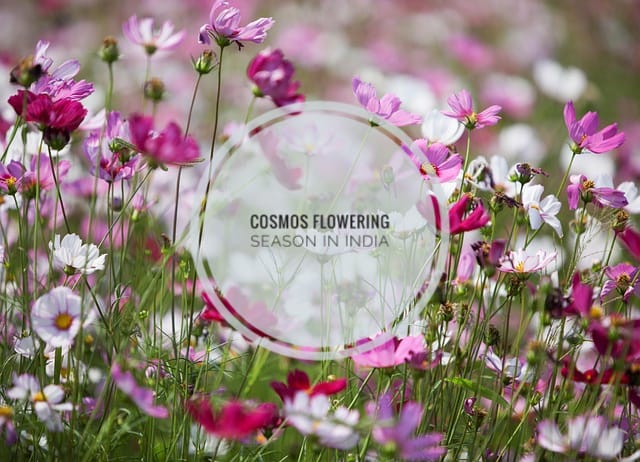Cosmos flowering season in India is a sight every gardener looks forward to, as these cheerful blooms brighten gardens from September to March.
Their vibrant pink, white, and orange flowers sway gracefully in the breeze, creating a lively and joyful atmosphere. Cosmos are low-maintenance, hardy, and perfect for both beginners and experienced gardeners looking to add long-lasting color to their outdoor spaces.
INTRODUCTION
Cosmos are among the easiest and most rewarding flowers to grow. They thrive in Indian climates, tolerate poor soil, and require little care once established.
Their name, derived from the Greek word kosmos, means “beautiful order,” perfectly matching their symmetrical petals and balanced form.
Let’s take a closer look at this plant before diving deeper.

| Feature | Description |
|---|---|
| Common Name | Cosmos |
| Scientific Name | Cosmos bipinnatus, Cosmos sulphureus |
| Family | Asteraceae |
| Native Region | Mexico and South America |
| Flower Colors | Pink, white, orange, yellow, and crimson |
| Plant Type | Annual flowering plant |
| Height | 1 to 4 feet (some varieties taller) |
| Flowering Season in India | September to March (depending on region) |
| Soil Type | Well-drained, moderately fertile soil |
| Sunlight Requirement | Full sunlight for at least 6 hours daily |
HISTORY AND ORIGIN
Cosmos flowers originally came from Mexico and parts of South America. Spanish explorers brought them to Europe in the 16th century, where they quickly became popular in cottage gardens.
The plant’s name, Cosmos, was chosen by Spanish priests who admired its evenly spaced petals and saw divine harmony in their structure. Over time, cosmos spread across Asia and Africa, eventually reaching India through colonial botanical exchanges.
Today, they’re a common sight in Indian gardens, loved for their extended blooming season and minimal care requirements.
COSMOS FLOWERING SEASON IN INDIA
In India, cosmos bloom mainly from September to March, depending on the region and temperature.
In northern states, the ideal sowing period is July to August, just before the monsoon retreats. Flowers start appearing from late September and continue well into winter and early spring.
In southern India, where winters are mild, cosmos can be planted almost year-round. The best flowering period, however, remains October to February, when temperatures stay between 15°C and 30°C.
If grown in hill stations, cosmos bloom beautifully from April to June during the cooler summer months. Their adaptability makes them one of the most versatile flowering plants in Indian gardens.
GROWING CONDITIONS
Cosmos plants thrive best in simple, well-balanced environments. They don’t need rich soil or heavy fertilizers.
Soil: Use light, well-drained soil. A slightly sandy mix works best since cosmos dislike waterlogged roots.
Climate: They grow well in warm and moderate climates with low humidity.
Spacing: Keep at least 30–40 cm between plants to maintain good airflow.
Temperature: Cosmos prefer temperatures between 18°C and 30°C. They stop blooming when nights get too cold or too hot.
These simple conditions are enough for strong, upright plants and bright, long-lasting blooms.

VARIETIES OF COSMOS FLOWERS
There are several beautiful cosmos varieties available for Indian gardens. Each has its own appeal, color range, and ideal climate.
1. COSMOS BIPINNATUS (GARDEN COSMOS)
The most popular type with delicate pink, white, and purple flowers.
- Native Place: Mexico
- Fruit Name: Achene (dry seed-like fruit)
- Climate Type: Mild to warm temperate
2. COSMOS SULPHUREUS (YELLOW COSMOS)
Known for its bright yellow and orange blooms, this type handles heat better.
- Native Place: Central America
- Fruit Name: Achene
- Climate Type: Warm and tropical
3. COSMOS ATROSANGUINEUS (CHOCOLATE COSMOS)
A rare variety with deep maroon petals and a faint chocolate scent.
- Native Place: Mexico
- Fruit Name: Achene
- Climate Type: Mild to moderate cool
4. SONATA SERIES
Compact and bushy cosmos ideal for containers or borders.
- Native Place: Hybrid variety
- Fruit Name: Achene
- Climate Type: Warm and humid
5. SEA SHELL SERIES
Unique tubular petals that resemble seashells, giving a textured look to gardens.
- Native Place: Cultivated hybrid
- Fruit Name: Achene
- Climate Type: Moderate
CARE TIPS
Once your cosmos are growing well, a little routine care will keep them in full bloom for months.
Pruning: Regularly remove faded flowers (deadheading) to encourage fresh blooms and prevent the plant from going to seed too early.
Propagation: Cosmos grow easily from seeds. Sow directly into the garden during the end of monsoon or early winter.
Fertilizing: Avoid heavy feeding. Too much nitrogen encourages leafy growth instead of flowers. A mild compost mix is enough once a month.
Support: Tall varieties may need light staking during windy or rainy weather to keep them upright.
Soil Maintenance: Loosen the soil surface occasionally to improve aeration and root health.

COMMON PROBLEMS AND SOLUTIONS
| Problem | Solution |
|---|---|
| Aphids or Whiteflies | Spray neem oil or soapy water weekly. |
| Powdery Mildew | Ensure good air circulation and avoid overhead watering. |
| Root Rot | Avoid overwatering; use well-drained soil. |
| Leggy Growth | Pinch off the top early to promote branching. |
| Low Blooming | Reduce fertilizer and ensure full sunlight exposure. |
USES AND BENEFITS
Cosmos flowers aren’t just pretty—they play an important role in ecological balance.
Ornamental Use: Ideal for borders, flower beds, and cut arrangements. Their long stems make them perfect for vases.
Environmental Benefit: Cosmos attract pollinators like bees, butterflies, and ladybugs, helping nearby plants thrive.
Medicinal Use: Traditional healers in Central America used cosmos leaves for treating minor skin irritations.
Cultural Role: The plant symbolizes peace, harmony, and order—reflecting its symmetrical petals.
Educational Gardens: Because of their easy growth, cosmos are great for school and beginner gardening projects.
INTERESTING FACTS ABOUT COSMOS
- The name Cosmos means “order” in Greek, symbolizing harmony in nature.
- The chocolate cosmos is now extinct in the wild and survives only through cultivation.
- Cosmos flowers are edible and sometimes used to decorate salads or desserts.
- They self-seed easily, coming back every season without much effort.
- NASA once grew cosmos in space to study plant growth under zero gravity.

FAQs
Q1: When is the best time to plant cosmos in India?
The best time to plant cosmos in India is between July and October for winter blooms. In southern regions, you can plant them even in early spring.
Q2: How long do cosmos flowers last once they bloom?
Each bloom lasts around a week, but the plant keeps producing flowers continuously for several months if cared for well.
Q3: Can cosmos grow in pots or containers?
Yes, cosmos grow beautifully in containers, especially compact varieties like Sonata. Just ensure 8-inch deep pots and full sunlight.
Q4: Do cosmos flowers attract insects?
Yes, cosmos attract pollinators like bees, butterflies, and ladybugs, which are beneficial for your garden’s ecosystem.
Q5: Why are my cosmos plants not flowering?
The most common reason is excessive nitrogen fertilizer or lack of sunlight. Reduce feeding and ensure 6–8 hours of direct light daily.
CONCLUSION
Cosmos are one of those flowers that make gardening feel effortless yet deeply rewarding. They thrive in Indian climates, bloom for months, and add unmatched vibrancy to any outdoor space. Whether you’re a beginner or an experienced gardener, cosmos will never disappoint.
Thanks for reading. Keep growing, keep exploring, and don’t forget to return here at gardeningbud.com for more plants, tips and gardening wisdom.
